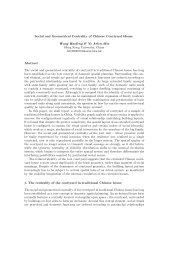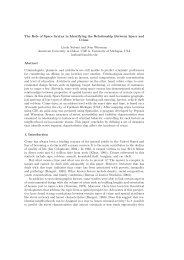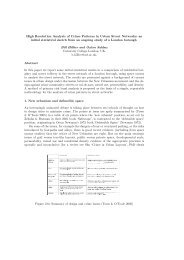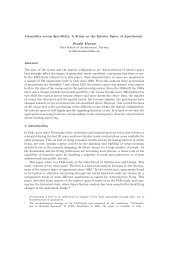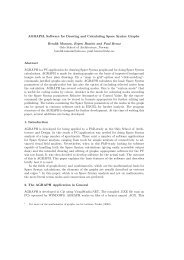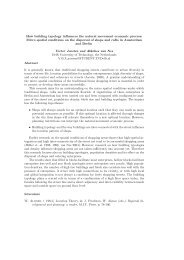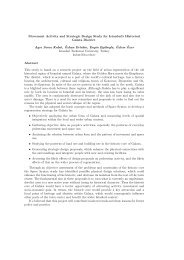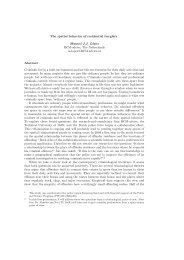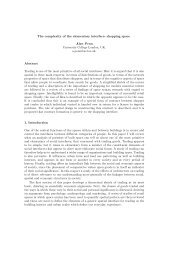Seen in a different light. Icons in Byzantine museums and churches ...
Seen in a different light. Icons in Byzantine museums and churches ...
Seen in a different light. Icons in Byzantine museums and churches ...
Create successful ePaper yourself
Turn your PDF publications into a flip-book with our unique Google optimized e-Paper software.
260 G. Stavroulaki <strong>and</strong> J. Peponis<br />
to perimeter) by add<strong>in</strong>g some “<strong>in</strong>visible local thresholds” of special <strong>in</strong>tensity. At Capnicarea,<br />
by contrast, thresholds are more entropically distributed. The overrid<strong>in</strong>g effect is<br />
not to emphasize the significance of the thresholds, but rather to make visitors aware of<br />
the cont<strong>in</strong>uous <strong>in</strong>terplay of the three underly<strong>in</strong>g spatial fields. In this regard, Castelvecchio<br />
<strong>and</strong> Capnicarea offer an <strong>in</strong>terest<strong>in</strong>g, if perhaps highly eclectic, contrast. We might<br />
<strong>in</strong>tuitively say that Castelvecchio stages the view<strong>in</strong>g subjects <strong>in</strong> relation to the art, while<br />
Capnicarea immerses them. Stag<strong>in</strong>g would imply the com<strong>in</strong>g to occupy prom<strong>in</strong>ent positions,<br />
the com<strong>in</strong>g <strong>in</strong>to focus with respect to def<strong>in</strong>ite <strong>and</strong> special relationships. Immers<strong>in</strong>g<br />
would imply a cont<strong>in</strong>uous movement <strong>in</strong> a field of cont<strong>in</strong>uous transformations, as described<br />
here.<br />
The stag<strong>in</strong>g <strong>and</strong> immers<strong>in</strong>g of subjects would be varieties of highly embodied experience,<br />
entail<strong>in</strong>g an engagement of movement, see<strong>in</strong>g <strong>and</strong> feel<strong>in</strong>g. This bears on a fundamental<br />
characteristic which the two sett<strong>in</strong>gs have <strong>in</strong> common. No attempt is made to mark, to<br />
architecturally underscore, any of the experiential <strong>and</strong> perceptual thresholds <strong>in</strong> question.<br />
The thresholds only become apparent as subjects become attentive to the relevant properties<br />
of spatial fields <strong>and</strong> as they come to occupy particular positions. In fact, the primacy<br />
of embodied experience arises precisely because of the non-correspondence between two<br />
k<strong>in</strong>ds of thresholds: first, the thresholds which are overtly def<strong>in</strong>ed by the build<strong>in</strong>g (for<br />
example, the transition between rooms <strong>in</strong> Castelvecchio, the def<strong>in</strong>ition of the ma<strong>in</strong> part<br />
of the church under the dome <strong>in</strong> Capnicarea); <strong>and</strong> second, the thresholds created by the<br />
<strong>in</strong>terplay of spatial relationships of potential co-visibility, <strong>light</strong><strong>in</strong>g <strong>and</strong> <strong>in</strong>tersect<strong>in</strong>g gazes.<br />
6. Museum recontextualization<br />
In contrast to the church, the ma<strong>in</strong> room of the Byzant<strong>in</strong>e museum <strong>in</strong> Athens which is<br />
devoted to icons is a simple large rectangle with no <strong>in</strong>ternal subdivisions, other than those<br />
produced by hang<strong>in</strong>g the icons themselves. Most of the icons exhibited are taken from<br />
the chancel screen of the church; thus they have two rather special characteristics. First,<br />
the gazes emanat<strong>in</strong>g from them are usually, even though not exclusively frontal as is the<br />
tendency <strong>in</strong> icons specifically <strong>in</strong>tended for that particular location. Second, icons are often<br />
double sided. In figure 110a we show the field of visible area <strong>and</strong> <strong>in</strong> figure 110b we show<br />
the field of gazes. There is no need to show the <strong>light</strong> field as <strong>light</strong><strong>in</strong>g is artificial <strong>and</strong><br />
illum<strong>in</strong>ation uniformly bright.<br />
The room is organized so as to echo the aspects of the zon<strong>in</strong>g of space of the church.<br />
There is a layer of space immediately adjacent to the entrance, similar to the outer narthex,<br />
<strong>and</strong> a second parallel layer similar to the <strong>in</strong>ner narthex, followed by a larger <strong>and</strong> more<br />
compact area, analogous to the ma<strong>in</strong> church. Furthermore, there is a central axis of longitud<strong>in</strong>al<br />
symmetry. This, however, is where similarities end. The most panoramic views<br />
are afforded at the threshold between the second layer <strong>and</strong> the <strong>in</strong>ner space. Gazes <strong>in</strong>tersect<br />
more densely with<strong>in</strong> the second layer itself. Thus, the larger area of the <strong>in</strong>ner space<br />
emphasizes the potential importance of the relatively fewer icons displayed towards it. In<br />
this <strong>in</strong>stance, greater space works to imply greater importance without enabl<strong>in</strong>g a more<br />
<strong>in</strong>tricate pattern of exploration. While church space seems to be implicitly didactic by<br />
explicitly creat<strong>in</strong>g a field of immersion, museum space seems explicitly didactic by express<strong>in</strong>g,<br />
<strong>in</strong> the uneven distribution of area, an implicit hierarchy of value. This seems to<br />
be simultaneously artistic <strong>and</strong> symbolic. All icons are artistically significant, the last pair,<br />
which is emphasized by the arrangement, shows Jesus <strong>and</strong> the Virg<strong>in</strong> Mary.


